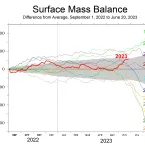
Ice Sheets Today
Data images and analyses of polar ice sheet melt conditions
Melt Analyses
Our scientific data analysis articles for the Greenland Ice Sheet melt season are typically published from April 1 to November 1. Antarctic Ice Sheet melt season articles are published from November 1 to April 1. Select an article below to explore ice sheet melt conditions by month and year-to-date.
Filter by:

Beginning October 15, 2025, NSIDC’s Ice Sheets Today services will be reduced because of non-renewed funding.

Greenland
A strong and persistent melt event occurred in southern Greenland in mid-August 2025, preceded by extensive rain in the same area. Snow cover following the rain events covered the lower elevation bare ice areas along the western side, brightening the surface again.

Northern Hemisphere
Greenland
A moderately intense melt season for the Greenland Ice Sheet has continued in July, with an extended period of high temperatures and coastal melting in mid-July where nearly half of the ice sheet experienced melt.

Northern Hemisphere
Arctic
Greenland
Surface melting on the Greenland Ice Sheet is on a slightly above-average track for the 2025 melt season, with melt along the western coast leading the way.

Antarctica
Melting on the Antarctic Ice Sheet for the 2024 to 2025 season began with above average melt extents in all regions, but melt extent dropped to nearly zero or below average from February 1 to March 15. Net accumulation of snow, part of the ice sheet’s surface mass balance, was far above average for the year, helping reduce the ice sheet’s net contribution to sea level rise for this period.

Antarctica
Surface melting for the Antarctic ice sheet appears to have set a record for the 46-year satellite observation period on January 2, 2025. All areas of the Antarctic coast that generally see significant summertime melting continue to accumulate melt days at a faster-than-average pace, except along the northern West Antarctic ice shelves, which are now near-average.

Antarctica
Southern Hemisphere
Widespread coastal melting occurred in Antarctica through the second half of December and is continuing in the first few days of the new year in several areas. Nearly every region with routine surface snowmelt has had more days of melt than is typical for this time of year.

Antarctica
Melt events on both sides of the Antarctic Peninsula and along the Dronning Maud coastal ice shelves between December 15 and 19 combined to produce an early-season record melt extent of just below 2 percent of the Antarctic Ice Sheet for December

Greenland
The 2024 melt season for the Greenland Ice Sheet ended with the second-lowest cumulative daily melt extent in this century, ranking twenty-eighth in the satellite record, which began in 1979. A late summer heat wave along the northwestern ice sheet closed out the season.

Greenland
The 2024 melt season for the Greenland Ice Sheet is above the 1991 to 2020 average, but the total number of melt days and peak melt area for Greenland are within the midrange of the last 24 years.

Northern Hemisphere
Greenland
North America
On April 25, 2024, a moderately strong melt event kicked things off early on the Greenland Ice Sheet. Since then, however, the melt season has been fairly typical. Snowfall in early June blanketed exposed ice, which will slow the onset of more intense melting and run off for the next few weeks. Overall, melting in Greenland has remained well above the 1980s and 1990s levels since 2013, but the 2012 season remains a distinct record.

Antarctica
Southern Hemisphere
In late February and early March, two record melt events for that time of year occurred on the Antarctic Peninsula. Overall, however, the 2023 to 2024 melt season was slightly below the 45-year average because of low melt regions outside of the Antarctic Peninsula.

Antarctica
Ice sheet surface melt on the Antarctic Peninsula abruptly dropped in mid-January and remained low through February 15. By contrast, melt day totals for the season were above average for the northern Larsen C and George VI Ice Shelves.

Antarctica
With the melt season well underway in the Southern Hemisphere, several ice shelves extending from the Antarctic Ice Sheet show above average melting, with significant melting in the Antarctic Peninsula region.

Antarctica
Greenland
As of December 15, the Antarctic Ice Sheet had above average melt in the Amery and Dronning Maud Land Ice Shelf regions, with significant melting on the Antarctic Peninsula. Greenland’s 2023 melt season was the third highest on record.

Antarctica
Greenland
NSIDC has launched an upgraded and streamlined Ice Sheets Today website. The new site replaces the site previously known as Greenland Today and Antarctica Today. Ice Sheets Today offers easy access to melt statistics and scientific analysis of ice sheet conditions.

Greenland
A strong weather pattern from August 21 to 24 caused widespread melting across Greenland. This unusually late summer melt event was caused by a high and low air pressure configuration known as an omega pattern because of its jet stream shape.

Greenland
Late June ushered in a significant shift in weather and melting for Greenland, particularly for the southern portion of the ice sheet, known as South Dome, where melting is currently on a record pace. Melting along the northern rim of the ice sheet is also greater than average.

Greenland
The melt season for the Greenland Ice Sheet has been near-average so far, with cool conditions in northern Greenland despite warm weather in nearby Arctic Canada. A small region of the ice sheet may not be properly mapped as it shows a higher number of melt days than is likely considering the observed weather for that area.

Antarctica
The Antarctic Peninsula has had an intense melt season with above average melting persisting through much of February. Saturated snow from a high melt year and low sea ice in Bellingshausen Sea have led to a series of minor calving events on the Wilkins Ice Shelf. Elsewhere in Antarctica, melting was near average.